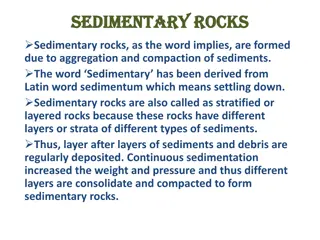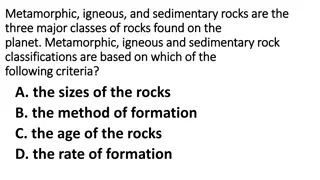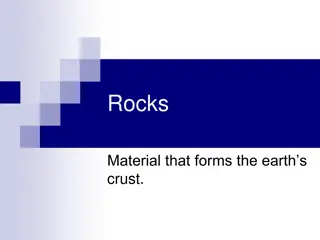Igneous Petrology: Rocks Formation & Influence
Igneous rocks, formed from lava or magma, come in extrusive and intrusive forms with unique geological structures. The relationship between igneous bodies and surrounding rocks plays a crucial role in their formation. Explore the various types and characteristics of igneous rocks as discussed by Dr. A.V. Tejankar in this informative content.
Download Presentation

Please find below an Image/Link to download the presentation.
The content on the website is provided AS IS for your information and personal use only. It may not be sold, licensed, or shared on other websites without obtaining consent from the author.If you encounter any issues during the download, it is possible that the publisher has removed the file from their server.
You are allowed to download the files provided on this website for personal or commercial use, subject to the condition that they are used lawfully. All files are the property of their respective owners.
The content on the website is provided AS IS for your information and personal use only. It may not be sold, licensed, or shared on other websites without obtaining consent from the author.
E N D
Presentation Transcript
IGNEOUS PETROLOGY Dr. A.V.Tejankar Professor & Head Dept. of Geology Deogiri College, Aurangabad
Igneous Rocks Igneous Rocks - Forms of Igneous Rocks- Plutonic & Hypabasal, Common Igneous Rocks and relation of their Constituent Minerals, Classification of Igneous Rocks, Structure and Textures, Suitability of Igneous Rocks for Building and Foundation, Megascopic Description of Common Igneous Rock Types.
Introduction Among the different types of rocks, igneous rocks are most abundant. They are also known as primary rocks.
Forms of Igneous Rocks Igneous rocks are formed out of very hot lava or magma. The extruded (or thrown out) lava on solidification over the earth s surface give rise to extrusive rocks. The magma on solidification below the earth s surface give rise to intrusive rocks. The extrusive rocks occur as simple lava flow. The intrusive rocks, on the other hand, assume different forms (or shapes) which in turn are influenced by geological structures occurring in country rocks and fluidity (i.e.. viscosity) of magma.
Forms of Igneous Rocks
Forms of Igneous Rocks Based on the relation of an igneous body with the attitude of associated country rocks, their forms are called concordant or discordant. If an igneous body is parallel to or occur along bedding planes of country rocks. Its forms is called concordant. On the other hand. If it cuts across the surrounding rocks, it is called discordant. bedding planes of
Concordant or Discordant
Forms of Igneous Rocks Influencing factor Magma, after its formation under the influence of pressure exerted by a huge overburden, attempts to move upwards, forcefully. In its upward journey, when magma strata, their bedding planes offer convenient and suitable sites for magmatic intrusion or injection. Thus, the bedding planes play an important role in the formation of igneous bodies. sedimentary reaches
Forms of Igneous Rocks
Forms of Igneous Rocks Another influencing factor in the types of form of an intrunsive igneous body is the nature of fluidity of magma. The fluidity or viscosity of magma is dependent on its silica content. Through magma has no fixed composition, it is usually either silica-rich or silica poor. Viscous magmas do not spread easily but have a tendency to pile up at a place. The basic magmas being less viscous easily spread over larger areas. The three typical forms of igneous intrusions, namely, sill, laccoliths and batholith, can be explained by this property of the viscous nature of magma.
Forms of Igneous Rocks The most common forms of intrusive igneous bodies as observed in the field are dyke, sill, laccoliths, lopolith, phacolith, , volcanic neck or plug, batholith, pyroclasts are forms of bodies. etc, lava flows and extrusive igneous
Forms of Igneous Rocks Dykes are like walls and act as barriers for the flow of underground water. Thus, like quartz veins, they interrupt the ground water movement which in good or bad potential of ground water in a region. Dykes may give rise to new spring or seal old springs Dykes may cause oil accumulation and thereby contribute to the occurrence of oil and gas deposits. As dykes are hard, durable black and fine grained, they are used in making statues, sculptures, etc
Forms of Igneous Rocks























